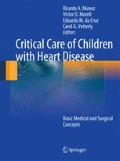Abstract
In the cardiac patient, especially during the first postoperative night, rapid hemodynamic changes may occur. The use of invasive continuous monitoring devices helps to detect complications early. Everyone working bedside has to keep in mind that repeated careful clinical observation by the experienced nurse and medical doctor is fundamental in all bedside monitoring. If monitoring devices show ambiguous results, a careful clinical examination usually resolves the problem. The best “monitor” is the intelligent, experienced, and committed caregiver.
Access this chapter
Tax calculation will be finalised at checkout
Purchases are for personal use only
References
Humes RA, Porter CJ, Puga FJ, et al. Utility of temporary atrial epicardial electrodes in postoperative pediatric cardiac patients. Mayo Clin Proc. 1989;64:516–521.
Webb R, Ralston A, Runciman W. Potential errors in pulse oximetry.II. Effects of changes in saturation and signal quality. Anaesthesia. 1991;46:202–206.
Nadkarni UB, Shah AM, Deshmukh CT. Non-invasive respiratory monitoring in paediatric intensive care unit. J Postgrad Med. 2000;46:149–152.
Park M, Menard S. Accuracy of blood pressure measurements by the Dinamap monitor in infants and children. Pediatrics. 1987;79:907–914.
Schindler E, Kowald B, Suess H, et al. Catheterization of the radial or brachial artery in neonates and infants. Paediatr Anaesth. 2005;15:677–682.
Sheridan RL, Weber JM. Mechanical and infectious complications of central venous cannulation in children: lessons learned from a 10-year experience placing more than 1000 catheters. J Burn Care Res. 2006;27:713–718.
Medin DL, Brown DT, Wesley R, et al. Validation of continous thermodilution cardiac output in critically ill patients with analysis of systematic errors. J Crit Care. 1998;13:184–189.
Linton RA, Jonas MM, Tibby SM, et al. Cardiac output measured by lithium dilution and transpulmonary thermodilution in patients in a paediatric intensive care unit. Intensive Care Med. 2000;26:1507–1511.
Tibby SM, Hatherill M, Marsh MJ, et al. Clinical validation of cardiac output measurements using femoral artery thermodilution with direct Fick in ventilated children and infants. Intensive Care Med. 1997;23:987–991.
Murdoch IA, Marsh MJ, Tibby SM, et al. Continous haemodynamic monitoring in children: use of transesophageal Doppler. Acta Paediatr. 1995;84:761–764.
Tibby SM, Hatherill M, Murdoch IA, et al. Use of transesophageal Doppler ultrasound in ventilated pediatric patients: derivation of cardiac output. Crit Care Med. 2000;28:2045–2050.
Daubeney PE, Pilkington SN, Janke E, et al. Cerebral oxygenation measured by near- infrared spectroscopy: comparison with jugular bulb oximetry. Ann Thor Surg. 1996;61:930–934.
Hofer A, Haizinger B, Geiselseder G, et al. Monitoring of selective antegrade cerebral perfusion using near infrared spectroscopy in neonatal aortic arch surgery. Eur J Anaesthesiol. 2005;22:293–298.
Nagdyman N, Fleck R, Barth S, et al. Relation of cerebral tissue oxygenation index to central venous oxygenation saturation in children. Intenisve Care Med. 2004;30:468–471.
Weiss M, Dullenkopf A, Kolarova A, et al. Near-infrared spectroscopic cerebral oxygenation reading in neonates and infants is associated with central venous oxygen saturation. Paediatr Anaesth. 2005;15:102–109.
Author information
Authors and Affiliations
Corresponding author
Editor information
Editors and Affiliations
Rights and permissions
Copyright information
© 2009 Springer-Verlag London Limited
About this chapter
Cite this chapter
Lechner, E. (2009). Monitoring of the Cardiac Patient. In: Munoz, R., Morell, V., Cruz, E., Vetterly, C. (eds) Critical Care of Children with Heart Disease. Springer, London. https://doi.org/10.1007/978-1-84882-262-7_10
Download citation
DOI: https://doi.org/10.1007/978-1-84882-262-7_10
Published:
Publisher Name: Springer, London
Print ISBN: 978-1-84882-261-0
Online ISBN: 978-1-84882-262-7
eBook Packages: MedicineMedicine (R0)

